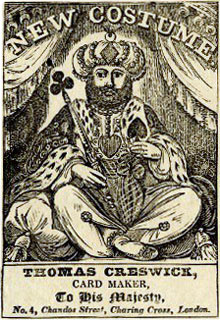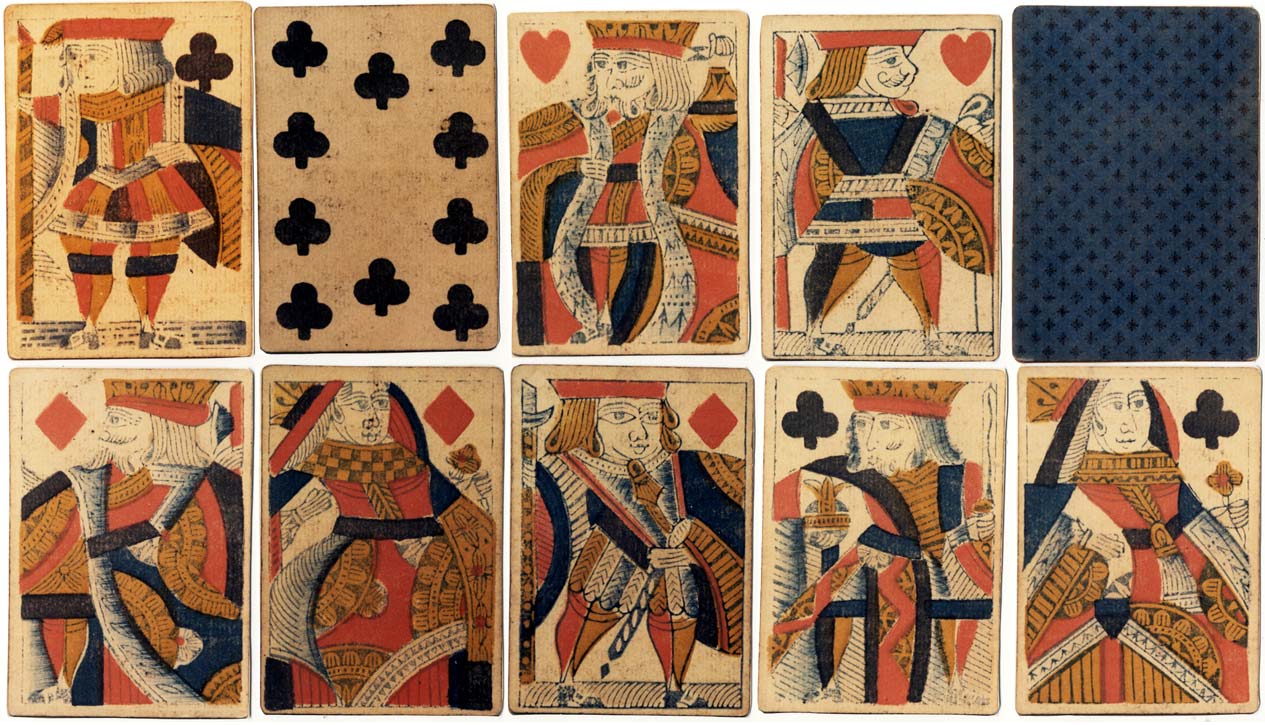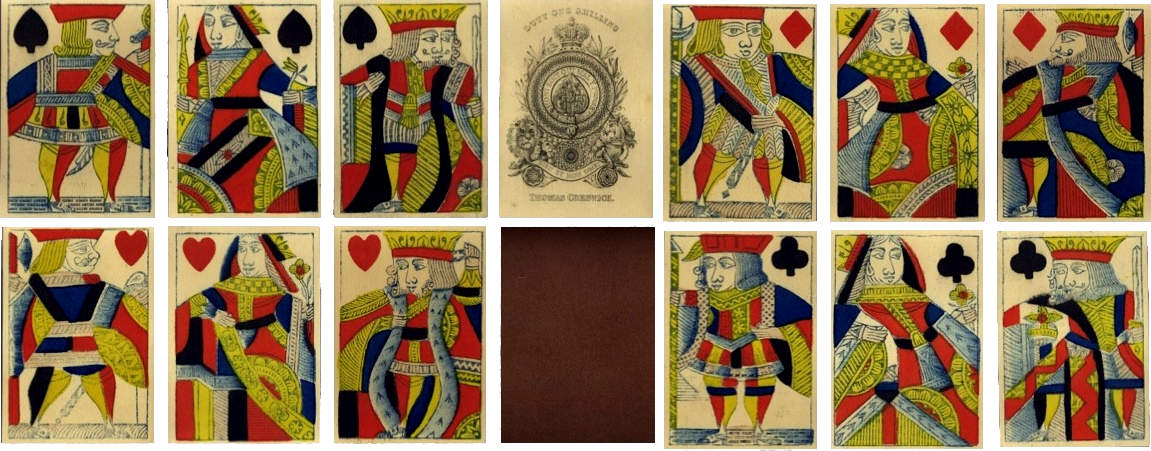Thomas Creswick
Thomas Creswick was a paper-maker and wholesale stationer. Playing cards were produced from c.1820 onwards.

Thomas Creswick, 16 Skinner Street, Snow Hill, London
Thomas Creswick was a paper-maker and wholesale stationer who first entered the card business in 1812. Standard woodblock & stencil playing cards were produced from c.1820 onwards, following the traditional designs, including smaller-sized piquet packs and a special non-standard pack featuring historical kings and queens of various nations in c.1830 (shown below). Advertisements of the day mentioned that Creswick took great pains to make cards which slip easily in the hand whilst also introducing improvements in the manufacturing process. Duty Aces of Spades were registered from c.1820, and an exportation Ace of Spades in 1828.
Creswick was appointed as manufacturer of paper and cards to William IV in 1831 and he advertised as such in 1834. Thomas Creswick died at 12 Clarendon Place, Maida Vale in September 1840, age 66, described as cardmaker and stationer of Chandos St (Gentleman's Magazine, 1840, vol.168, p.553).


Above: standard pack of English playing cards with 'Garter' Ace of Spades manufactured by Thomas Creswick, c.1825. The court cards in this example are of the type used by Josiah Stone. There seems to have been some kind of take-over c.1825, as there is reference in the taxation records to Creswick's taking over a number of Stone Garter ASs. More usually Creswick uses Type IV court cards (shown below).

Above: standard pack of English playing cards with 'Frizzle' Ace of Spades manufactured by Thomas Creswick, c.1830. This pack uses Creswick's more usual type of court card designs, except the red jacks which are of the Stone Type II kind. Image courtesy Ken Lodge.
King of Clubs. Pope wrote “That long behind he trails his pompous robes. And, of all the monarchs only grasps the globe”. The title “King of Clubs” was bestowed by Johnson on the Literary Club.
In his advertising sheet dating to about 1832, Creswick informed his customers that he had removed his ‘Warehouse and Manufactory’ to larger and more commodious premises at 4 Chandos St, ‘where he has now room enough for the sale of Paper of every variety, as well as the goods of his own Production’. As well as writing paper and playing cards, he offered various of his own papers, including ‘prepared smooth and rough surface’ white drawing papers, ‘tinted and coloured Drawing Papers, Originally invented by him with prepared Surface…’
Below: pack produced by Thomas Creswick in c.1830 with 'Old Frizzle' Ace of Spades depicting historical Kings and Queens of various nations. The Kings and Queens are unnamed but are evidently meant to represent actual people. The King of Clubs is Henry VIII.


Above: Imperial Playing cards prospectus on fly leaf of New Monthly Magazine, Dec. 1827. Source gallica.bnf.fr / Bibliothèque nationale de France • Imperial Playing Cards prospectus►
REFERENCES:
Lodge, Ken: The Standard English Pattern (second revised and enlarged edition), Bungay, Suffolk, 2010
For more about Creswick, see Ken Lodge's blog, pages 15 and 19: →

By Simon Wintle
Member since February 01, 1996
Founder and editor of the World of Playing Cards since 1996. He is a former committee member of the IPCS and was graphics editor of The Playing-Card journal for many years. He has lived at various times in Chile, England and Wales and is currently living in Extremadura, Spain. Simon's first limited edition pack of playing cards was a replica of a seventeenth century traditional English pack, which he produced from woodblocks and stencils.
Related Articles

Victorian grocer’s scale plate
Large flat plate decorated with highly coloured English cards and royal arms.

Queen of Arts
A wide variety of women artists celebrated on cards with illustrations by Laura Callaghan.

The Glasgow Pack
Issued to celebrate Glasgow’s reign as European City of Culture in 1990, with city views and works o...

Cathedrals, Abbeys & Minsters playing cards
54 pictures of different famous cathedrals, abbeys and minsters in England and Wales.

Christmas Carols
Christmas Carols playing cards illustrated by Stuart Dilks

Pam is the Knave of Clubs
Playing cards as metaphors in 18th century art - from fate, chance and social hierarchy t...

Question and Answer Games
A card game called “Impertinent Questions and Pertinent Answers” was launched in the early 1920s by ...

Dr Sacheverell
Dr. Henry Sacheverell's impeachment in 1710 sparked widespread public unrest and political upheaval,...

Leadmill playing cards
Promotional pack for an arts centre in Sheffield with designs by Martin F. Bedford.

Agatha Christie and card games
Agatha Christie uses card-play as a primary focus of a story, and as a way of creating plots and mot...

English Heritage
52 different colour photos of historic sites managed by English Heritage.

The Malt Whiskies of Scotland
Three packs featuring photographs by Duncan McEwan of malt whisky distilleries in Scotland.

Typographic Playing Cards
Typographic Playing Cards designed by Jim Sutherland, c.2010.

76: Transitions: Hunt & Sons
Styles change and technology develops. This means that it's possible to see transition periods in th...

Gibson’s History of England
History without tears for young and old, 1920s.

Simpson (Piccadilly) playing cards
Innovative advertising pack for Simpsons of Piccadilly designed by André François.
Trending Articles
Popular articles from the past 28 days


